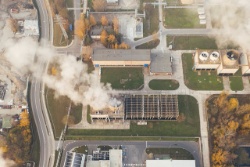Inmates, tagging and... butterflies?
Inmates, tagging and... butterflies?
Now that
autumn’s arrived butterfly lovers around New Zealand are
tagging Monarch butterflies. And in a few weeks they’ll
hear from a USA scientist how tagging is helping prisoners
in a Washington State Penitentiary.
Associate Professor David James, from Washington State University will stress the importance of tagging Monarchs at the conference of the Monarch Butterfly NZ Trust at Unitec, Mt Albert, on 16 and 17 March, explaining how inmates from Washington penitentiaries are helping.
Monarchs typically form large clusters, sometimes with hundreds or thousands of butterflies, to survive the colder winter months. In New Zealand many of these sites are unknown; in North West America Monarchs overwinter on the Californian coast. The Sustainability in Prisons project has teamed up inmates, prison staff and scientists to help restore endangered species and habitats.
The inmates raise Monarch butterflies from eggs in their cells, tag them – and then James releases them into the outdoors.
“It’s been a really exciting programme and has had a positive impact, says Associate Superintendent Chris Bowman. “Our goal is to give the inmates something to look forward to when they wake up in the morning.”
“From a mental health standpoint this has been very beneficial for the inmates,” said Tamara Russell, clinical director of Washington State Penitentiary’s Residential Mental Health Unit. "We know that having an activity that allows inmates to give back to the community helps alleviate depression from long-term incarceration. It gives them a focus and a purpose for their lives. They're involved in something bigger than themselves that has meaning.”
And James is thrilled.
“Last November I had a report of one of our Washington State reared and released Monarchs resighted on 30 October in a home garden in Bolinas, California,” he said. “This female was tagged and released on 17 September in Yakima, Washington – a distance of about 1000 kilometres (620 miles).
In New Zealand the longest distance reported has been a Monarch which flew from Pukawa Bay, near Turangi and was seen alive and well three weeks later at Whangarei, some 400 kilometres away.
Even though the Monarchs are sexually
mature, it isn’t until the onset of spring that mating and
breeding is triggered
Over the autumn and winter tiny,
white tags are applied to the hindwing of each Monarch. Each
tag bears the Trust’s website address and a unique number,
but are virtually weightless.
Butterflies are uniquely placed to act as indicators of environmental change.
“The status of our flora and fauna depends on the effects of environmental conditions on our natural world,” said Jacqui Knight, Secretary of the Monarch Butterfly New Zealand Trust. “Such things as pollution, climate change, alien species and land management all change our world. We need to know more about our insects to predict the impacts of such change, and to develop an appropriate response.”
“By tagging and following Monarchs we can use them as indicators of the status of our environment here in NZ,” she said. “They are large and colourful and easy to see.”
There will be a lot to learn at the conference and the event is raising considerable excitement among teachers, gardeners and conservation-minded people.
ends


 Brewers Association: Brewers Association Of New Zealand Supports Modernisation Of Alcohol Legislation
Brewers Association: Brewers Association Of New Zealand Supports Modernisation Of Alcohol Legislation Commerce Commission: ComCom Warns Of Pyramid Schemes After South Auckland Scammers Plead Guilty
Commerce Commission: ComCom Warns Of Pyramid Schemes After South Auckland Scammers Plead Guilty MBIE: MBIE Publish Mid-Point Review Of The Phase-Out Of The Low Fixed Charge (LFC)
MBIE: MBIE Publish Mid-Point Review Of The Phase-Out Of The Low Fixed Charge (LFC) Science Media Centre: Company Claims To Have “De-Extincted” The Dire Wolf – Expert Reaction
Science Media Centre: Company Claims To Have “De-Extincted” The Dire Wolf – Expert Reaction Stats NZ: Greenhouse Gas Emissions Fall 2.0 Percent In The December 2024 Quarter
Stats NZ: Greenhouse Gas Emissions Fall 2.0 Percent In The December 2024 Quarter The Reserve Bank of New Zealand: Christian Hawkesby Appointed As Governor Of The RBNZ
The Reserve Bank of New Zealand: Christian Hawkesby Appointed As Governor Of The RBNZ



